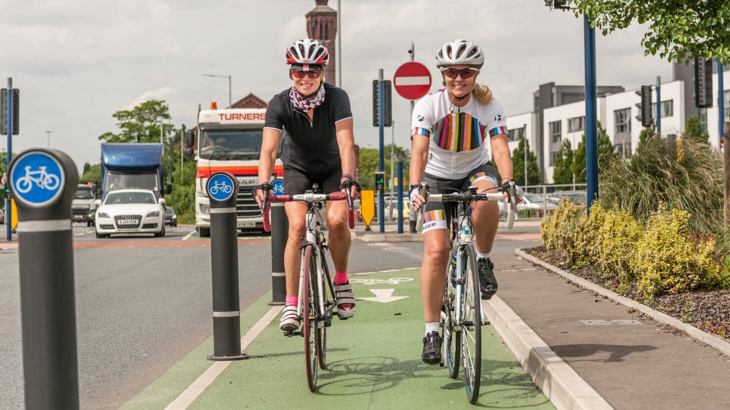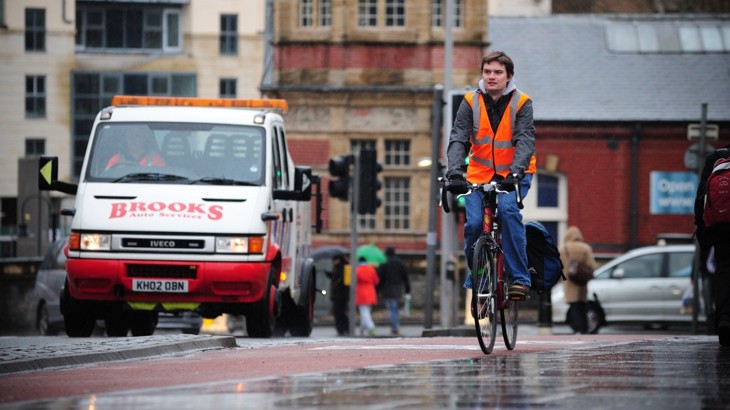Rachel White, our Head of Public Affairs, recently gave evidence to the Transport Select Committee with Living Streets and Cycling UK as part of their active travel inquiry. The message was clear: without adequate funding, the Cycling and Walking Investment Strategy will fail.

In her blog, Rachel looks at the strategy put forward by the UK Government and discusses the complex reasons preventing people from choosing to walk or cycle and what is needed to overcome them.
The Cycling and Walking Investment Strategy (CWIS) has three aims by 2025. One is incredibly unambitious – to increase walking to 300 stages per person per year - which we will meet as its less than one walking stage per day. The other two – arguably also fairly unambitious compared to continental Europe, and yet, at least stretching for England, we are currently on course to fail. The aim is to double cycling based on 2013 levels and increase the numbers of children aged 5-10 walking to school to 55%. Last year the number of these children walking to school fell by 2% to 51%.
So where are we going wrong?
We have a strategy in place for walking and cycling; a Government that is looking at some of the safety issues that affect those actively travelling through reviewing the Highway Code; and an ambitious set of Local Cycling and Walking Infrastructure Plans (LCWIPs) being formed. These are positive steps, but without the funding to change the public realm and put in place a network of protected cycleways across our towns and cities, they will be undermined and ineffective.
Yesterday, I was asked what the obstacles are that prevent people from choosing to walk and cycle short journeys. Truthfully, there are many complex reasons but I highlighted five areas that particularly prevent people from making an active choice:
1. Safety and perceptions of safety
Many people are still put off cycling in particular, because of fears for their safety. In our Bike Life surveys of 7,700 people across seven cities, 30% (27% of women) of those surveyed felt cycling safety was good in their cities and only 21% felt children’s cycling safety was good.
2. Poor infrastructure/infrastructure in the wrong place
We need high-quality infrastructure, such as pedestrianised areas with seating and protected cycleways which go to places people want to go. This is particularly important for women.
Women make nearly three times fewer cycling journeys than men in this country.
Women are more likely to trip-chain (a chained trip includes a stop on the way to another destination) and do radial trips which are not as well catered for. Only 46% of women in Bike Life cities felt cycling infrastructure was good. Count data from cities across the USA revealed that females account for a greater percentage of bike riders when better bicycle infrastructure such as protected cycleways, are in place.
3. Convenience
We need to make walking and cycling the natural choice. This often means taking space from motor vehicles such as removing car parking spaces to create protected cycleways and widening pavements, and there is an appetite for this. Bike Life found 78% of people would like more protected space for cycling even if this meant taking space away from motor vehicles.
4. Confidence
More cycle training is needed. Many people often don’t feel confident on a bike. We do need more training both in schools where cycle training should be available to all primary school children to instil confidence and skills from a young age but also with adults.

The benefits of being physically active compared to sitting in the car far outweigh the costs of exposure to pollution anywhere in the UK.
5. Perceptions of health: Air quality and exposure
The belief that you are more exposed to air pollution outside a car than inside a car is particularly an issue in cities. This is wrong apart from on the busiest roads if you are situated right behind a tailpipe.
Importantly, the benefits of being physically active compared to sitting in the car far outweigh the costs of exposure anywhere in the UK.
How do we overcome these obstacles
Three out of five of these obstacles: safety, poor infrastructure and convenience can be largely overcome through good cycling and walking infrastructure and at present Local Cycling and Walking Infrastructure Plans (LCWIPs) are being formed in a number of local authorities in England.
The potential of LCWIPs is large. They are an opportunity for local authorities to put long-term plans in place for walking and cycling, such as planning in cycling networks across the towns or cities in their area.
The formation of the plans is funded but they are in danger of gathering dust on a shelf unless there is funding to roll-out the cycling and walking projects identified in the plans. This funding currently doesn’t exist.
Only approximately 2% of England’s transport spending is spent on walking and cycling. LCWIPs highlight the desperate need for more funding if we are to see better and plentiful infrastructure for cycling and walking, which will help increase cycling numbers and safety to encourage more families to allow their children to walk and cycle the school journey.
This is why all three of our organisations yesterday called for the UK Government, as part of its forthcoming Spending Review, to adopt a second CWIS (CWIS2) with resources that are consistent with its stated aims and ambitions. This will require CWIS2 to amount to 5% of total transport spending in 2020/21, rising to 10% over the five years of the next spending round (i.e. by 2024/25).
Based on figures for 2016/17 transport spending in England excluding London, this would amount to £17 per person annually (for walking as well as cycling) in 2020/1, rising to £34 per person in 2024/5.
This is not unprecedented. Scotland has committed to 10% of its trunk road budget to go towards walking and cycling. England urgently needs to follow suit and give the LCWIPs the financial backing they need to be a success and to create an environment in which other local authorities can begin to produce and enact these plans.
It’s not too late to turn things around and reach the CWIS targets for walking and cycling. The forthcoming spending review is an opportunity for the UK Government to show exactly how committed they are to achieving these targets.

